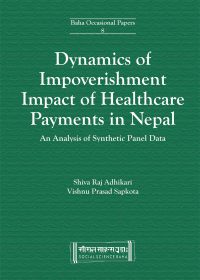Publications
Dynamics of Impoverishment Impact of Healthcare Payments in Nepal
Poverty dynamics discusses the length of time people experience poverty and explains the movement into and out of poverty, and the evidence on poverty dynamics is important for policymakers to design appropriate anti-poverty policies. The dynamics of poverty are also determined by healthcare payments, and panel data is central to obtaining a better understanding of poverty dynamics. Due to the absence of panel data, the paper constructs a synthetic panel dataset using two rounds of cross-sectional surveys in 2003/04 and 2010/11 in Nepal to assess the poverty dynamics. The results indicate that chronic poverty, without adjusting healthcare payments, is almost 21 per cent for 2003/04 and 2010/11, and chronic poverty increases by one per cent due to healthcare payments. Additionally, the movement of non-poor to the poor is increased by healthcare payments, and the capacity of households to move from poor to non-poor is reduced by the healthcare payments. Chronic poverty exists in all regions, marginalised and ethnic groups, and Dalit (occupational caste) groups. The limitation of this approach is that the incidence of poverty estimated from a hybrid dataset may not be directly comparable with the estimation of poverty through a conventional approach. This dynamic approach captures the economic mobility of households and supports the design of appropriate anti-poverty policies that are required to address chronic or transitory poverty.
Baha-occasional-papers-8
